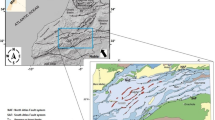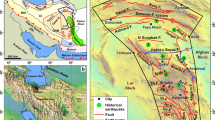Abstract
Azerbaijan is characterized by a strong level of seismicity with earthquakes concentrated within several active areas. In this study, we calculated the source mechanism of earthquakes occurring in the northeastern part of Azerbaijan, by using the digital waveform data recorded by the Republican Seismic Survey Center (RSSC) at the Azerbaijan National Academy of Sciences (ANAS) during the period from 2003 to 2017. Polarity of the first motion of a P-wave was the main criteria for focal mechanism solutions with high reliability. In investigation of the different tectonic deformations and modern stress field pattern in the tectonic areas of the northeastern part of Azerbaijan, the focal mechanism solutions were applied. The results show mainly a thrust faulting mechanism with few events displaying also normal faulting or strike-slip faulting. The World Stress Map (WSM) Create A Stress Map Online (CASMO) and Cataclastic Analysis Method are used in the current research for defining the regional stress field orientations. Western and central parts of the Greater Caucasus ridge are mainly characterized by northeastern–southwestern (NE–SW) tension. In the eastern part, the tension reverses into intensive compression. Additionally, the transformation of sinistral strike-slip motion into predominant right-lateral strike-slip motion can be obviously traced southward from mountain ridges of the Greater Caucasus. The differences between these characteristics are considered for the large tectonic zones (Balaken–Zagatala, Sheki–Oguz–Gabala, Ismailli–Shamakhi). In the Zagatala region of the studied area, the NW–SE orientation of the compression axes is observed, while in the Sheki region, orientation stretches towards N–S and smoothly extends clockwise towards NE–SW orientation in the Caspian Sea. The tension axis is mostly directed towards NE–SW and N–S which is linked with the heat of the Kur depression under the zone of the Greater Caucasus. Significant spatial variations in orientations of the axes of principal stresses in the shear zone and their local weak gentle variations are evidence of a consistent general stress in the NE–SW direction.



From Kangarli (2007)










Similar content being viewed by others
References
Ali-Zadeh, A. A., Agabekov, M. G., Shekinskiy, E. M., & Shikhalibeyli, E. S. H. (1980). Tectonic map of Azerbaijan. Scale 1:500000. Baku: Geological Institute, Azerbaijan Academy of Sciences, USSR.
Alizadeh, A. A., Guliyev, I. S., Kadirov, F. A., Eppelbaum, L. V. (2016). Geosciences of Azerbaijan. Volume I: geology, (p. 340). Springer International Publishing. https://doi.org/10.1007/978-3-319-27395-2.239.
Babayev, G. (2010). About some aspects of probabilistic seismic hazard assessment of Absheron peninsula. Republican Seismic Survey Center of Azerbaijan National Academy of Sciences. Catalogue of Seismoprognosis Research Carried Out in Azerbaijan Territory in 2009, “Teknur”, Baku, 2010, pp. 59–64 (in Russian).
Babayev, G. R., Akhmedova, E. V., & Kadirov, F. A. (2017). Analysis of stress-strain state of Caucasus region (Azerbaijan) on the basis of maximum horizontal stress vectors and world stress map: application technique. Geophysical Journal,39(3), 26–39. https://doi.org/10.24028/gzh.0203-3100.v39i3.2017.104026. (in Russian).
Babayev, G., Ismail-Zadeh, A., & Le Moüel, J.-L. (2010). Scenario-based earthquake hazard and risk assessment for Baku (Azerbaijan). Natural Hazards and Earth Systems Sciences,10, 2697–2712.
Babayev, G., Tibaldi, A., Bonali, F., & Kadirov, F. (2014). Evaluation of earthquake-induced strain in promoting mud eruptions: the case of Shamakhi–Gobustan–Absheron areas, Azerbaijan. Natural Hazards,72(2), 789–808.
Barth, A., Reinecker, J. & Heidbach, O. (2008). Stress derivation from earthquake focal mechanisms World Stress Map Project, Technical Report. pp 12. http://dc-app3-14.gfzpotsdam/de/pub/guidelines/WSM_analysis_guideline_focal_mechanisms.pdf. Accessed 30 Sept 2019.
Bergerat, F. (1987). Stress fields in the European platform at the time of Africa–Eurasia collision. Tectonics,6, 99–132.
Chernykh, K. F. (1988). Introduction to anisotropic elasticity (p. 190). Moscow: Nauka. (in Russian).
Gasanov, A. (2003). Earthquakes of Azerbaijan for 1983–2002 (p. 185). Baku: Elm. (in Russian).
Heidbach, O., Barth, A., Connolly, P., Fuchs, K., Müller, B., Reinecker, J., et al. (2004). Stress maps in a minute: the 2004 World Stress Map release. Eos Transactions,85, 521–529.
Heidbach, O., Tingay, M., Barth, A., Reinecker, J., Kurfeß, D., & Müller, B. (2008) The World Stress Map database release. https://doi.org/10.1594/gfz.wsm.rel2008.
Kadirov, F. A. (2000). Gravity field and models of deep structure of Azerbaijan (p. 112). Baku: Nafta-Press.
Kadirov, F. A. (2004). Gravity model of lithosphere in the Caucasus-Caspian region. South-Caspian Basin: geology, geophysics, oil and gas content (pp. 107–121). Baku: Nafta-Press.
Kadirov, F., Floyd, M., Alizadeh, A., Guliev, I., Reilinger, R. E., Kuleli, S., et al. (2012). Kinematics of the Eastern Caucasus near Baku, Azerbaijan. Natural Hazards,63, 997–1006. https://doi.org/10.1007/s11069-012-0199-0.
Kadirov, F. A., Floyd, M., Reilinger, R., Alizadeh, A., Guliyev, I. S., Mammadov, S. G., et al. (2015). Active geodynamics of the Caucasus region: implications for earthquake hazards in Azerbaijan. Proceedings of Azerbaijan National Academy of Sciences, The Sciences of Earth,3, 3–17.
Kadirov, F. A., Gadirov, A. G., Babayev, G. R., Agayeva, S. T., Mammadov, S. K., Garagezova, N. R., et al. (2013). Seismic zoning of the southern slope of greater Caucasus from the fractal parameters of the earthquakes, stress state and GPS velocities. Izvestiya, Physics of the Solid Earth,49(4), 554–562. (original in Russian).
Kangarli, T. N. (2007). The peculiarities of the geological and tectonic structure of the south-eastern part of Caucasus and oil and gas bearing problems. Scientific Proceedings State Oil Company of Azerbaijan Republic,9, 3–12. (in Russian).
Khain, V. E., & Alizade, A. K. A. (2005). Geology of Azerbaijan: volume IV tectonics (pp. 214–234). Baku: Nafta-Press.
Kisslinger, C., Bowman, J. R., & Koch, K. (1981). Procedures for computing focal mechanisms from local (SV/P) data. Bulletin of the Seismological Society of America,71, 1719–1729.
Mammadli, T. Y. (2012). Seismogenic zones of Azerbaijan and their depth structural features. In Seismoforecasting researches carried out in the Azerbaijan territory (pp. 287–296). Baku: Nafta-Press.
Mohamed, E. K., Hassoup, A., Abou-Elenean, K. M., Othman, A. A., & Hamed, D. E. M. (2015). Earthquakes focal mechanism and stress field pattern in the northeastern part of Egypt. NRIAG Journal of Astronomy and Geophysics,4, 205–221.
Nemčok, M., Feyzullayev, A., Kadirov, A., Zeynalov, G., Allen, R., Christensen, C., et al. (2011). Neotectonics of the Caucasus and Kura valley, Azerbaijan. Global Engineers and Technologist Review,1(1), 1–14.
Rebetsky-Yu, L., Kuchai, O. A., Sycheva, C., & Tatevossian, R. (2012). Development of inversion methods on fault slip data. Stress state on in orogenes of the Central Asia. Tectonophysics. https://doi.org/10.1016/j.tecto.2012.09.027.
Rebetsky-Yu, L., & Polets-Yu, A. (2018). The method of cataclastic analysis of discontinuous displacements. In S. Damico (Ed.), Moment tensor solutions—a useful tool for seismotectonics (pp. 111–162). Cham: Springer. https://doi.org/10.1007/978-3-319-77359-9_6.
Shikhalibeyli, E. (1996). Some problematic aspects of geological structures and tectonics of Azerbaijan (pp. 48–82). Baku: Elm. (in Russian).
Solonenko, A. V., Solonenko, N. A., Melnikova, V. I., Kozmin, B. M., Kuchay, O. A., & Sukhanova, S. S. (1993). Stress and slip in the earthquakes foci of Siberia and Mongolia: seismicity and seismic zoning of Northern Eurasia 1 (pp. 113–122). Moscow: IPE RAS.
Stein, S., & Wysession, M. (2003). An introduction to seismology, earthquakes, and earth structure (p. 512). Hoboken: Blackwell Publishing.
Telesca, L., Kadirov, F., Yetirmishli, G., Safarov, R., Babayev, G., & Ismaylova, S. (2017). Statistical analysis of the 2003–2016 seismicity of Azerbaijan and surrounding areas. Journal of Seismology,21, 1467–1485. https://doi.org/10.1007/s10950-017-9677-x.
Telesca, L., Lovallo, M., Babayev, G., & Kadirov, F. (2013). Spectral and informational analysis of seismicity: an application to the 1996–2012 seismicity of Northern Caucasus–Azerbaijan part of Greater Caucasus–Kopet Dag Region. Physica-A Statistical Mechanics and Its Applications,392, 6064–6078. https://doi.org/10.1016/j.physa.2013.07.031.
Yamaji, A. (2000). The multiple inverse method: a new technique to separate stresses from heterogeneous fault–slip data. Journal Structure Geology,22, 441–452.
Yetirmishli, G. J., Abdullayeva, R. R., Kazimova, E. S., & Ismayilova, S. S. (2015). Strong earthquakes on the territory of Azerbaijan for the period of 2012–2014. Seismoprognosis Observations in the Territory of Azerbaijan,12(1), 19–26.
Yetirmishli, G. J., Kazimova, S. E. (2017) Types of tectonic movements of the seismogenic areas of Azerbaijan based on the earthquake focal zones. Geological-geophysical studies of the deep structure of the Caucasus: Geology and Geophysics of Caucasus, Vladikavkaz, p 20–25 (in Russian).
Yetirmishli, G. J., & Kazimova, S. E. (2018). Focal mechanisms of earthquakes and stress field of the earth crust in Azerbaijan. Part of the Springer Natural Hazards Bookseries. Moment tensor solutions (pp. 481–495). New York: Springernature.
Yetirmishli, G. J., Kazimova, S. E., Ismailova, S. S. & Garaveliyev E. S. (2016). Dynamic and kinematics characteristics of earthquakes of Sheki-Oguz region. Proceedings of Earth’s Sciences Azerbaijan National Academy of Sciences, vol 3–4, pp. 28–36.
Yetirmishli, G. C., Mammadli, T. Y., & Kazimova, S. E. (2013). Features of seismicity of Azerbaijan part of the greater Caucasus. Journal of Georgian Geophysical Society Issue (A), Physics of Solid Earth,16, 55–60.
Acknowledgements
The research was done under the financial support from the Science Development Foundation at President of Azerbaijan within the framework of the grant EİF-KETPL-2015-1(25)-56/27/2 entitled “Investigation of geodynamic and volcanic activity, strain and deformation state of Azerbaijan territory”. The study was also supported by the bilateral project CNR-ANAS 2018–2019 and was performed at International Laboratory of Geology and Geophysics Institute of Azerbaijan National Academy of Sciences and Institute of Methodologies for Environmental Analysis National Research Council (Italy) “Earthquake space–time analysis and hazard laboratory (ESTAHL)”.
Author information
Authors and Affiliations
Corresponding author
Additional information
Publisher's Note
Springer Nature remains neutral with regard to jurisdictional claims in published maps and institutional affiliations.
Electronic supplementary material
Below is the link to the electronic supplementary material.
Rights and permissions
About this article
Cite this article
Babayev, G., Yetirmishli, G., Kazimova, S. et al. Stress Field Pattern in the Northeastern Part of Azerbaijan. Pure Appl. Geophys. 177, 2739–2751 (2020). https://doi.org/10.1007/s00024-019-02371-5
Received:
Revised:
Accepted:
Published:
Issue Date:
DOI: https://doi.org/10.1007/s00024-019-02371-5




